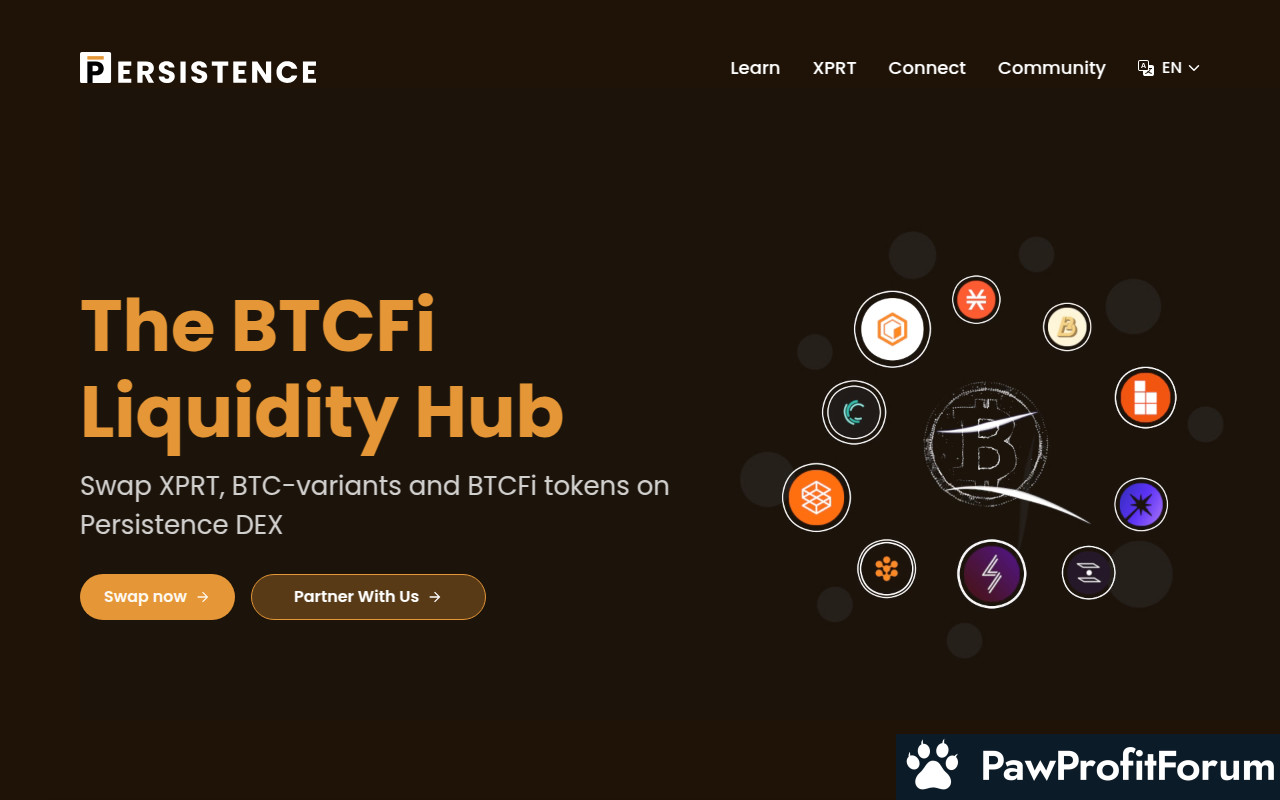Persistence One is building the BTCFi Liquidity Hub, enabling fast, near zero-slippage swaps for XPRT, BTC-variants, and BTCfi tokens on Persistence DEX.
BTCFi’s rapid growth has created multiple BTC-related assets, making fragmentation a big challenge. Persistence One will provide a single liquidity hub, simplifying value transfer across the Bitcoin ecosystem.
At the core of Persistence One's innovation is its Bitcoin Cross-chain Swaps solution. This feature facilitates fast, zero-slippage, and secure swaps across Bitcoin Layer 2s, enhancing the interoperability and efficiency of transactions within the blockchain ecosystem. The platform's emphasis on security ensures that users can engage in these swaps with confidence, knowing their assets are protected.
Persistence One also stands out for its commitment to IBC (Inter-Blockchain Communication) interoperability. This allows seamless interaction between different blockchain networks, fostering a more connected and efficient DeFi environment. By enabling cross-chain functionality, Persistence One enhances the utility and accessibility of digital assets across various platforms.
The platform's focus on unlocking staked asset liquidity addresses a significant challenge in the DeFi space, where assets often remain locked and underutilized. Through innovative DeFi applications, Persistence One provides opportunities for users to maximize the potential of their staked assets, driving greater value and efficiency in the market.
One of the standout features of Persistence One is its use of Cross-chain Intents. This technology is designed to revolutionize the user experience in BTCfi (Bitcoin Finance) by removing barriers to Bitcoin movement. Cross-chain Intents enable users to perform transactions across different blockchain networks without the need for intermediaries, ensuring fast and secure swaps. For instance, this technology allows for Bitcoin Cross-chain Swaps, enabling fast, zero-slippage secure swaps across Bitcoin Layer 2s.
Security is a paramount concern for any blockchain platform, and Persistence One addresses this through several mechanisms. The Cosmos technology on which it is built employs a consensus algorithm known as Tendermint. Tendermint ensures that all transactions are validated by a network of nodes, making it extremely difficult for bad actors to manipulate the blockchain. This consensus mechanism also provides Byzantine Fault Tolerance (BFT), which means the network can continue to operate correctly even if some nodes act maliciously or fail.
In addition to its robust security features, Persistence One also offers unique financial services. It facilitates the borrowing of cryptoassets using real-world assets as collateral. This capability bridges the gap between traditional finance and the crypto world, providing users with more options for leveraging their assets. For example, a user can use their real estate property as collateral to borrow cryptocurrency, thus accessing liquidity without having to sell their physical assets.
The decentralized liquid staking ecosystem created by Persistence One allows users to stake their assets and earn rewards while maintaining liquidity. This is particularly beneficial for users who want to participate in staking but do not want to lock up their assets for extended periods. By providing a way to stake assets without sacrificing liquidity, Persistence One enhances the flexibility and usability of staking in the DeFi space.
Persistence One's technology stack is further enriched by its focus on interoperability. The platform's ability to interact with multiple blockchain networks seamlessly is a significant advantage. This interoperability is facilitated by the Inter-Blockchain Communication (IBC) protocol, which is a key feature of the Cosmos ecosystem. IBC allows different blockchains to communicate and transfer assets and data between each other, making the entire ecosystem more cohesive and efficient.
The combination of Cross-chain Intents, Tendermint consensus, Byzantine Fault Tolerance, and Inter-Blockchain Communication positions Persistence One as a versatile and secure platform in the blockchain space. These technologies work together to provide a comprehensive solution for decentralized finance, enabling users to move assets across different blockchains, stake their assets with liquidity, and borrow against real-world collateral.
Another significant application of Persistence One is in the decentralized finance (DeFi) sector. Persistence One supports liquid staking, which enables users to stake their assets and earn rewards while still maintaining liquidity. This means that users can continue to use their staked assets for other financial activities, such as borrowing and lending, without having to wait for the staking period to end.
Persistence One also plays a crucial role in providing a trading and liquidity venue for XPRT, Bitcoin (BTC), and related assets. This functionality is essential for maintaining a healthy and active market, ensuring that users can easily buy, sell, and trade their assets. Additionally, Persistence One's platform supports on-chain activities, which are vital for the seamless operation of decentralized applications (dApps) and other blockchain-based services.
Furthermore, Persistence One integrates with other blockchain platforms to facilitate cross-chain swaps and the trading of non-fungible tokens (NFTs). This integration allows users to move assets between different blockchains effortlessly, enhancing the overall interoperability of the blockchain ecosystem. By enabling these cross-chain interactions, Persistence One helps to break down barriers between different blockchain networks, fostering a more connected and efficient digital economy.
Persistence One's applications extend to revolutionizing user experience in BTCfi, a sector focused on improving the usability and accessibility of Bitcoin-related financial services. By removing barriers to BTC movement and providing innovative solutions for asset management, Persistence One is contributing to the broader adoption and utility of blockchain technology in everyday financial activities.
One of the pivotal moments for Persistence One was the launch of their Persistence DEX. This decentralized exchange is designed to offer seamless trading experiences, leveraging the security and efficiency of blockchain technology. The DEX aims to provide users with a platform that minimizes slippage and maximizes transaction speed, addressing common issues faced by traders in the decentralized finance (DeFi) space.
Another significant milestone was the release of their progressive web wallet. This wallet enhances user accessibility and security, allowing users to manage their XPRT tokens and other assets with ease. The progressive web wallet is designed to be user-friendly, ensuring that both novice and experienced users can navigate the platform without difficulty.
Persistence One has also made strides with the implementation of a project for their Persistence Core chain. This core chain is integral to the ecosystem, providing the foundational infrastructure for various applications and services within the Persistence network. The development of the Persistence Core chain underscores the project's commitment to building a robust and scalable blockchain solution.
In addition to these developments, Persistence One has established a repository for automated validator selection. This repository is crucial for maintaining the integrity and security of the network, as it ensures that validators are selected in a transparent and efficient manner. The automated validator selection process helps to decentralize the network further, promoting trust and reliability among users.
Persistence One's focus on cross-chain swaps, particularly with Bitcoin, highlights their innovative approach to solving interoperability issues within the blockchain space. By enabling secure and efficient swaps across Bitcoin Layer 2s, Persistence One is addressing a critical need in the market, providing users with more flexibility and options for their digital assets.
The project's GitHub repository is a testament to their ongoing commitment to open-source development and community collaboration. By making their code and development processes transparent, Persistence One fosters a sense of trust and engagement within the blockchain community.
Persistence One continues to be a project with significant potential for growth, driven by its innovative solutions and commitment to enhancing the blockchain ecosystem.
BTCFi’s rapid growth has created multiple BTC-related assets, making fragmentation a big challenge. Persistence One will provide a single liquidity hub, simplifying value transfer across the Bitcoin ecosystem.
What is Persistence One?
Persistence One (XPRT) is a specialized Layer-1 blockchain built on CometBFT, designed to power a diverse ecosystem of decentralized finance (DeFi) applications. Its primary focus is on unlocking the liquidity of staked assets, a critical aspect in the evolving DeFi landscape. By leveraging its expertise in DeFi, IBC interoperability, and security, Persistence One aims to provide robust solutions for liquidity provisioning and yield generation through various DeFi protocols.At the core of Persistence One's innovation is its Bitcoin Cross-chain Swaps solution. This feature facilitates fast, zero-slippage, and secure swaps across Bitcoin Layer 2s, enhancing the interoperability and efficiency of transactions within the blockchain ecosystem. The platform's emphasis on security ensures that users can engage in these swaps with confidence, knowing their assets are protected.
Persistence One also stands out for its commitment to IBC (Inter-Blockchain Communication) interoperability. This allows seamless interaction between different blockchain networks, fostering a more connected and efficient DeFi environment. By enabling cross-chain functionality, Persistence One enhances the utility and accessibility of digital assets across various platforms.
The platform's focus on unlocking staked asset liquidity addresses a significant challenge in the DeFi space, where assets often remain locked and underutilized. Through innovative DeFi applications, Persistence One provides opportunities for users to maximize the potential of their staked assets, driving greater value and efficiency in the market.
What is the technology behind Persistence One?
Persistence One (XPRT) leverages advanced blockchain technology to create a decentralized liquid staking ecosystem. At its core, Persistence One is built on the Cosmos technology, which is known for its interoperability and scalability. This foundation allows Persistence One to facilitate seamless interactions between different blockchain networks, enhancing the overall user experience in the decentralized finance (DeFi) space.One of the standout features of Persistence One is its use of Cross-chain Intents. This technology is designed to revolutionize the user experience in BTCfi (Bitcoin Finance) by removing barriers to Bitcoin movement. Cross-chain Intents enable users to perform transactions across different blockchain networks without the need for intermediaries, ensuring fast and secure swaps. For instance, this technology allows for Bitcoin Cross-chain Swaps, enabling fast, zero-slippage secure swaps across Bitcoin Layer 2s.
Security is a paramount concern for any blockchain platform, and Persistence One addresses this through several mechanisms. The Cosmos technology on which it is built employs a consensus algorithm known as Tendermint. Tendermint ensures that all transactions are validated by a network of nodes, making it extremely difficult for bad actors to manipulate the blockchain. This consensus mechanism also provides Byzantine Fault Tolerance (BFT), which means the network can continue to operate correctly even if some nodes act maliciously or fail.
In addition to its robust security features, Persistence One also offers unique financial services. It facilitates the borrowing of cryptoassets using real-world assets as collateral. This capability bridges the gap between traditional finance and the crypto world, providing users with more options for leveraging their assets. For example, a user can use their real estate property as collateral to borrow cryptocurrency, thus accessing liquidity without having to sell their physical assets.
The decentralized liquid staking ecosystem created by Persistence One allows users to stake their assets and earn rewards while maintaining liquidity. This is particularly beneficial for users who want to participate in staking but do not want to lock up their assets for extended periods. By providing a way to stake assets without sacrificing liquidity, Persistence One enhances the flexibility and usability of staking in the DeFi space.
Persistence One's technology stack is further enriched by its focus on interoperability. The platform's ability to interact with multiple blockchain networks seamlessly is a significant advantage. This interoperability is facilitated by the Inter-Blockchain Communication (IBC) protocol, which is a key feature of the Cosmos ecosystem. IBC allows different blockchains to communicate and transfer assets and data between each other, making the entire ecosystem more cohesive and efficient.
The combination of Cross-chain Intents, Tendermint consensus, Byzantine Fault Tolerance, and Inter-Blockchain Communication positions Persistence One as a versatile and secure platform in the blockchain space. These technologies work together to provide a comprehensive solution for decentralized finance, enabling users to move assets across different blockchains, stake their assets with liquidity, and borrow against real-world collateral.
What are the real-world applications of Persistence One?
Persistence One (XPRT) is a cryptocurrency designed to enhance various aspects of blockchain technology and finance. One of its primary applications is in the realm of Bitcoin Cross-chain Swaps, which allows users to perform fast, secure swaps across different Bitcoin Layer 2 solutions without experiencing slippage. This capability is particularly beneficial for traders and investors who need to move assets quickly and efficiently between different blockchain networks.Another significant application of Persistence One is in the decentralized finance (DeFi) sector. Persistence One supports liquid staking, which enables users to stake their assets and earn rewards while still maintaining liquidity. This means that users can continue to use their staked assets for other financial activities, such as borrowing and lending, without having to wait for the staking period to end.
Persistence One also plays a crucial role in providing a trading and liquidity venue for XPRT, Bitcoin (BTC), and related assets. This functionality is essential for maintaining a healthy and active market, ensuring that users can easily buy, sell, and trade their assets. Additionally, Persistence One's platform supports on-chain activities, which are vital for the seamless operation of decentralized applications (dApps) and other blockchain-based services.
Furthermore, Persistence One integrates with other blockchain platforms to facilitate cross-chain swaps and the trading of non-fungible tokens (NFTs). This integration allows users to move assets between different blockchains effortlessly, enhancing the overall interoperability of the blockchain ecosystem. By enabling these cross-chain interactions, Persistence One helps to break down barriers between different blockchain networks, fostering a more connected and efficient digital economy.
Persistence One's applications extend to revolutionizing user experience in BTCfi, a sector focused on improving the usability and accessibility of Bitcoin-related financial services. By removing barriers to BTC movement and providing innovative solutions for asset management, Persistence One is contributing to the broader adoption and utility of blockchain technology in everyday financial activities.
What key events have there been for Persistence One?
Persistence One (XPRT) has carved a niche in the blockchain and cryptocurrency landscape with a series of impactful developments. The project is known for its innovative approach to cross-chain swaps, particularly focusing on Bitcoin Layer 2 solutions, which facilitate fast, zero-slippage secure swaps.One of the pivotal moments for Persistence One was the launch of their Persistence DEX. This decentralized exchange is designed to offer seamless trading experiences, leveraging the security and efficiency of blockchain technology. The DEX aims to provide users with a platform that minimizes slippage and maximizes transaction speed, addressing common issues faced by traders in the decentralized finance (DeFi) space.
Another significant milestone was the release of their progressive web wallet. This wallet enhances user accessibility and security, allowing users to manage their XPRT tokens and other assets with ease. The progressive web wallet is designed to be user-friendly, ensuring that both novice and experienced users can navigate the platform without difficulty.
Persistence One has also made strides with the implementation of a project for their Persistence Core chain. This core chain is integral to the ecosystem, providing the foundational infrastructure for various applications and services within the Persistence network. The development of the Persistence Core chain underscores the project's commitment to building a robust and scalable blockchain solution.
In addition to these developments, Persistence One has established a repository for automated validator selection. This repository is crucial for maintaining the integrity and security of the network, as it ensures that validators are selected in a transparent and efficient manner. The automated validator selection process helps to decentralize the network further, promoting trust and reliability among users.
Persistence One's focus on cross-chain swaps, particularly with Bitcoin, highlights their innovative approach to solving interoperability issues within the blockchain space. By enabling secure and efficient swaps across Bitcoin Layer 2s, Persistence One is addressing a critical need in the market, providing users with more flexibility and options for their digital assets.
The project's GitHub repository is a testament to their ongoing commitment to open-source development and community collaboration. By making their code and development processes transparent, Persistence One fosters a sense of trust and engagement within the blockchain community.
Persistence One continues to be a project with significant potential for growth, driven by its innovative solutions and commitment to enhancing the blockchain ecosystem.
Who are the founders of Persistence One?
Persistence One (XPRT) is a cryptocurrency project focused on building a Bitcoin Cross-chain Swaps solution, enabling fast, zero-slippage secure swaps across Bitcoin Layer 2s. The founders of Persistence One are Tushar Aggarwal, Deepanshu Tripathi, Mikhil Pandey, Hitesh Bhardwaj, and Deepanshu Tripati. Tushar Aggarwal, serving as the CEO, brings significant expertise and leadership to the project. Each founder contributes unique skills and experiences, driving the development and success of Persistence One.| Website | persistence.one |
| Website | docs.persistence.one |
| Socials | twitter.com/PersistenceOne |
| Socials | reddit.com/r/PersistenceOne |
| Socials | github.com/persistenceOne |
| Socials | t.me/PersistenceOneChat |
| Contracts | 0xD454...7f40C4 |
| Explorers | www.mintscan.io/persistence/ |
| Wallets | metamask.io/ |










